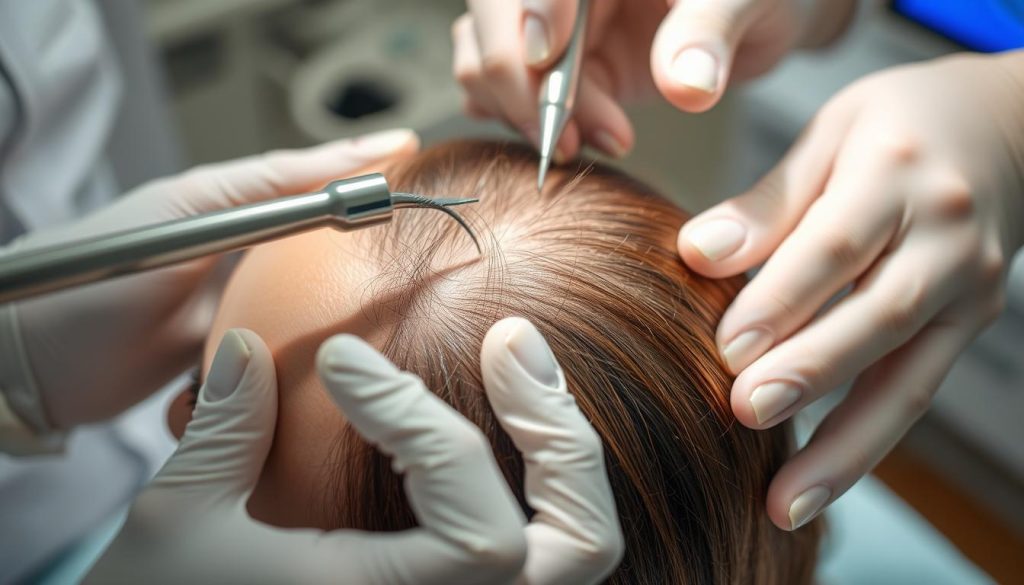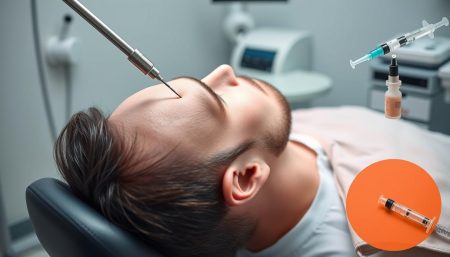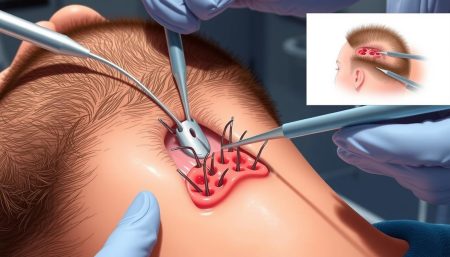Hair loss can be very upsetting for women, affecting how they feel about themselves. With new treatments, hair transplants for women are now a reliable option. They help those with thinning hair or bald spots.
Today’s hair restoration methods are designed for women’s needs. They give natural-looking results, fitting each woman’s hair loss pattern. More women are choosing hair transplants, showing how well they work in boosting confidence.
This guide covers hair transplants for women, from why they lose hair to picking the best treatment. We’ll look at the emotional side, the different techniques, and what to expect during the process.
Understanding Female Pattern Hair Loss and Its Impact
Millions of women worldwide suffer from female pattern hair loss. It causes distress and lowers self-esteem. This condition makes hair thin gradually, mainly on the crown and top of the head. It’s emotionally tough.
Knowing the causes, effects, and early signs is key. It helps find solutions and consider hair restoration surgery for ladies.
Common Causes of Hair Loss in Women
Several factors lead to hair loss in women:
- Hormonal changes during menopause
- Genetic predisposition
- Nutritional deficiencies
- Stress and anxiety
- Certain medical conditions

Psychological Effects of Female Hair Loss
Hair loss deeply affects a woman’s mental health. Many feel:
- Decreased self-confidence
- Social anxiety
- Depression
- Negative body image
These effects highlight the need for effective solutions. This includes hair restoration surgery for ladies when needed.
Identifying Early Signs of Female Pattern Baldness
Spotting early signs of female pattern baldness is vital:
| Sign | Description |
|---|---|
| Widening part | Hair part becomes more visible |
| Thinning crown | Noticeable hair loss on top of head |
| Increased shedding | More hair fall than usual during washing or brushing |
| Reduced ponytail volume | Thinner ponytail or need for extra hair ties |
Early detection leads to timely action. This can include hair restoration surgery for ladies. It helps address the issue and boost confidence.
Hair Transplants for Women: A Complete Guide
Hair transplants for women are now more common as a fix for female hair loss. They tackle the special challenges of women’s hair loss patterns. The method moves hair follicles from thick areas to thin ones, bringing back hair and confidence.
Women’s hair transplant methods aim to boost density, not just create a new hairline. This ensures the results look natural and fit in with the rest of the hair. The back of the head is often used for donor hair because it’s less affected by hormones.
When looking at the cost of women’s hair transplants, several things matter:
- How much hair is lost
- The number of grafts needed
- The transplant method used
- The surgeon’s skill
Prices vary a lot, starting at £3,000 and going up to £30,000 for big jobs. It’s key to talk to a skilled doctor to find the best option and cost for you.
Hair transplants for women are a lasting fix for hair loss. They give natural-looking results that can really boost self-confidence and life quality. As the methods get better, more women are finding hope against hair loss.
Evaluating Candidacy for Female Hair Restoration Surgery
Thinking about hair restoration surgery for ladies? It’s important to check if you’re a good candidate. Top hair transplant surgeons for women look at several key points to see if you’re right for the procedure.
Medical Prerequisites and Considerations
Before hair restoration surgery, a full medical check-up is needed. You should be in good health and not have conditions that could stop healing or hair growth. Important medical factors include:
- Scalp health and skin conditions
- Hormonal imbalances
- Autoimmune disorders
- Medications that may affect hair growth
Age and Hair Loss Pattern Requirements
Age and hair loss pattern are key in deciding if you’re a good candidate. While age isn’t a strict rule, most surgeons look for patients over 25. This ensures the hair loss pattern has settled. Women usually see diffuse thinning, unlike men’s distinct patterns.
Donor Hair Availability Assessment
Having enough donor hair is vital for successful surgery. Surgeons check the quality and amount of hair in the back and sides of your head. This helps figure out if the surgery is possible and what to expect.
| Factor | Importance | Assessment Method |
|---|---|---|
| Medical Health | High | Physical examination, blood tests |
| Age | Medium | Patient history |
| Hair Loss Pattern | High | Scalp examination, photographs |
| Donor Hair Quality | Critical | Microscopic analysis |

Experienced hair transplant surgeons carefully consider these factors to see if you’re a good candidate for surgery. This detailed check-up helps ensure the best results for women looking to regain their hair and confidence.
Modern Hair Transplant Techniques for Female Patients
Hair transplants for women have changed a lot. They now offer hope for those with thinning hair. New techniques tackle the special challenges of female hair loss, giving natural-looking results.

Follicular Unit Extraction (FUE) is a top choice for women’s hair transplants. It takes hair follicles from the donor area and puts them in thin spots. FUE is great for women because it causes little scarring and heals fast.
Direct Hair Implantation (DHI) is another new method. It uses a special tool to put hair follicles in thin spots all at once. This makes the hairline look natural and adds density to thin areas.
For those with a lot of hair loss, Scalp Micropigmentation (SMP) can be used with hair transplants. SMP tattoos the scalp to look fuller. It works with transplanted hair for a better solution.
“The key to successful hair transplants for women lies in customising the approach to each patient’s unique hair loss pattern and aesthetic goals,” says Dr Sarah Thompson, a leading hair restoration specialist.
With new hair transplant techniques, women with thinning hair have more choices. These modern methods bring hope for restoring hair, confidence, and self-esteem.
FUE vs FUT: Choosing the Right Procedure for Women
When looking into female hair loss treatment, it’s key to know the differences between FUE and FUT. Both are popular hair transplant methods. They offer unique benefits for women wanting to regain their hair.
Follicular Unit Extraction (FUE) Benefits
FUE is a gentle method that takes out individual hair follicles. It’s popular among women because it’s discreet and quick. The scars are small, so you can wear short hair without anyone noticing.
Follicular Unit Transplantation (FUT) Advantages
FUT, or the strip method, takes a strip of scalp. It’s good for women with a lot of hair loss. It can cover a lot of area, making it a strong option for those needing a lot of hair.
Recovery Time Comparison
The recovery times differ. FUE is quicker, with most women back to normal in a week. FUT takes a bit longer, but both can give natural-looking results with the right surgeon.

| Aspect | FUE | FUT |
|---|---|---|
| Scarring | Minimal | Linear scar |
| Recovery Time | 5-7 days | 10-14 days |
| Graft Yield | Lower | Higher |
Choosing between FUE and FUT depends on several factors. These include the extent of hair loss, desired results, and lifestyle. Talking to a hair restoration specialist can help find the best method for each woman’s needs.
Cost Analysis of Women’s Hair Transplant Procedures
Understanding the cost of women’s hair transplants is key for those thinking about it. The price can change a lot based on different things.
The amount of hair loss affects the cost a lot. Women with more hair loss need more grafts, making it pricier. The method used, like FUE or FUT, also changes the price.
Other costs include tests before the surgery, medicines after, and follow-up visits. These can add up, so remember to include them in your budget.
| Procedure Type | Average Cost Range (USD) | Grafts |
|---|---|---|
| FUE (Small Area) | 4,000 – 8,000 | 500 – 1,000 |
| FUE (Large Area) | 10,000 – 15,000 | 2,000 – 3,000 |
| FUT | 5,000 – 12,000 | 1,000 – 2,500 |
Insurance usually doesn’t cover hair transplants for women. But, many clinics offer payment plans to help with the cost. It’s good to look into these options to make it more affordable.
“Investing in a hair transplant is not just about restoring hair; it’s about restoring confidence and well-being.”
When planning your budget for a hair transplant, remember the cheapest isn’t always the best. Focus on quality and experience for the best results.
The Hair Transplant Journey: From Consultation to Recovery
Starting a hair transplant journey can be thrilling and a bit scary for women. Knowing what to expect is key for a good outcome. Let’s look at the main steps of this journey.
Initial Consultation Process
The first step is meeting a top hair transplant surgeon for women. They will check your hair loss, talk about what you want, and see if you’re a good fit. They’ll also explain your options and answer your questions.
Pre-operative Planning
After deciding to go ahead, planning starts. This includes:
- Blood tests to check your health
- Changing medications if needed
- Planning your hairline
- Setting a surgery date
Post-operative Care Guidelines
Recovering from a hair transplant is very important for women. Following your surgeon’s advice closely is key for the best results. Here are some important tips:
| Timeline | Care Instructions |
|---|---|
| First 24 hours | Rest with head up, avoid touching the grafts |
| Days 2-7 | Wash gently as told, avoid strong water |
| Weeks 2-4 | Start doing normal things slowly, keep scalp from sun |
| Months 1-3 | Wait patiently, losing hair is normal, keep hair care gentle |
Keep in mind, every woman’s recovery is different. Always ask your surgeon for specific advice during your hair restoration journey.
Natural-Looking Results: Artistic Aspects of Female Hair Restoration
The art of female hair restoration is key to getting natural results. Skilled surgeons look at facial features, hair patterns, and future hair loss. They design transplants for women with female pattern baldness.
Creating a natural hairline is all about where each hair is placed. Surgeons focus on hair direction and angle. This ensures the new hair blends well with the rest.
Female hair restoration faces unique challenges. It’s about keeping thinning areas dense while looking natural. Experienced surgeons use different techniques to meet these needs:
- Customised graft placement
- Careful angle and direction planning
- Gradual density transitions
Choosing a skilled surgeon is vital. Their artistic talent greatly affects the final look. It makes sure the new hair fits well with the patient’s appearance.
| Aspect | Importance in Female Hair Restoration |
|---|---|
| Hairline Design | Critical for natural-looking frame of the face |
| Density Distribution | Essential for seamless blend with existing hair |
| Angle and Direction | Key for mimicking natural hair growth patterns |
By paying attention to these artistic details, surgeons give women results that boost their confidence. These results effectively tackle their hair loss worries.
Non-Surgical Alternatives to Hair Transplantation
Women looking for non-surgical hair solutions have many options. These choices are great for those not ready for surgery or who prefer gentler treatments.
Medication Options
Minoxidil and finasteride are two medicines for hair loss in women. Minoxidil, a topical solution, helps hair grow and slows loss. Finasteride, a pill, blocks hormones that make hair thin.
PRP Therapy
Platelet-Rich Plasma (PRP) therapy is a new, non-surgical method. It uses your own blood to boost hair growth. Your blood’s platelets are injected into your scalp to stimulate new hair.
Scalp Micropigmentation
Scalp micropigmentation makes hair look fuller. It’s a cosmetic method where tiny pigment dots are placed in the scalp. This is great for those with thinning hair or small bald spots.
| Treatment | Procedure Type | Duration of Effects | Maintenance Required |
|---|---|---|---|
| Minoxidil | Topical application | Ongoing while using | Daily application |
| PRP Therapy | Injection | 6-12 months | Regular sessions |
| Scalp Micropigmentation | Cosmetic tattoo | 3-5 years | Touch-ups as needed |
These non-surgical options give women many choices for hair loss. Each has its own benefits and things to consider. This lets people pick the best option for their needs and likes.
Managing Expectations and Timeline for Results
It’s vital to understand the journey of hair transplants for women. The time from surgery to seeing results is long, and patience is essential. Photos of women’s hair transplants show amazing changes, but these are the final results after months.
Right after the surgery, the transplanted hair might fall out. This is normal and part of the hair growth cycle. New hair starts growing in 3-4 months. You’ll see big changes in 6-9 months, and full results in 12-18 months.
Several things can affect how fast your hair grows and the final look:
- Age and overall health
- Following the post-operative care instructions
- Individual hair characteristics
- Surgeon’s skill and technique
Keeping a positive outlook during recovery is key. Regular check-ups with your surgeon help track your progress and solve any issues. Remember, hair transplants for women are a long-term investment in your looks and confidence.
“The key to successful hair restoration is patience. Trust the process and embrace each stage of your hair’s regrowth journey.”
When looking at before and after photos, think about hair density, natural hairline, and overall look. A good result should look natural, blending well with your existing hair.
Selecting a Qualified Hair Transplant Surgeon
Finding the right hair transplant surgeon for women is key for successful hair restoration. The best specialist can greatly improve your results, making them look natural.
Essential Qualifications
Look for a surgeon with board certifications in dermatology or plastic surgery. Being a member of groups like the International Society of Hair Restoration Surgery (ISHRS) shows they’re committed to their work.
Experience with Female Patients
It’s important to choose a surgeon who has worked with women before. Women’s hair loss patterns are different from men’s, so they need special care. Ask about their experience with cases like yours and see photos of their work on female patients.
Portfolio Assessment
Examine the surgeon’s portfolio carefully. Look for natural hairlines, the right amount of hair, and consistent results. Make sure the transplanted hair looks like it belongs with the rest of your hair.
Meet with several surgeons to compare their approaches. Ask about their methods, success rates, and how they care for patients after surgery. This will help you find the perfect surgeon for your needs.
Post-Transplant Hair Care and Maintenance
Proper care after a hair transplant is key for the best results. Women recovering from hair transplant surgery need a special care plan. This guide will help you keep your transplanted hair healthy and your scalp in top shape.
Start with gentle washing in the early stages. Use lukewarm water and a mild shampoo your surgeon suggests. Gently pat dry with a soft towel, avoiding any rubbing that could harm the new follicles.
Styling should be kept simple at first. Stay away from heat styling tools and harsh chemicals for a month after surgery. Once you’re healing, you can start using gentle styling methods that don’t hurt your scalp.
Good nutrition is also important for your hair. Eat foods rich in proteins, vitamins, and minerals to help your hair grow strong. If you’re thinking about supplements for hair health, talk to your doctor first.
| Time Frame | Care Instructions |
|---|---|
| First Week | Avoid washing, sleep with head elevated |
| Weeks 2-4 | Gentle washing, no styling |
| Months 2-3 | Resume normal washing, light styling |
| After 3 Months | Regular hair care routine, protect from sun |
Make sure to have regular check-ups with your surgeon. These visits help track your progress and answer any questions. Remember, it can take up to a year to see the full results of your transplant.
Long-term Success Rates and Patient Satisfaction
Hair transplants for women have shown promising long-term results. Over 85% of female patients report significant improvement in hair density and overall appearance after their procedure.
The longevity of results depends on several factors. These include proper patient selection, surgical technique, and post-operative care. Graft survival rates typically range from 85% to 95%, leading to natural-looking, lasting outcomes.
“My hair transplant was life-changing. It’s been five years, and I’m thrilled with the results. My confidence has soared,” shares Sarah, a 42-year-old patient.
Women’s hair transplant before and after photos show remarkable transformations. Many patients report improved self-esteem and quality of life after successful hair restoration.
While individual results may vary, most women experience continued hair growth for years after their transplant. Regular follow-ups and proper hair care are key for maintaining optimal results. Challenges like hormonal changes or ongoing hair loss in non-transplanted areas can be addressed with supplementary treatments or touch-up procedures.
Overall, hair transplants for women offer a reliable solution for long-term hair restoration. They have high satisfaction rates and lasting results.
Combining Hair Transplants with Other Treatment Options
Women looking for solutions to female pattern baldness often find the best results come from a mix of treatments. Hair transplant techniques for thinning hair in women can be paired with other treatments. This approach helps address different aspects of hair loss, leading to a more successful restoration.
Medical treatments like minoxidil or finasteride can be used alongside hair transplants. These medications help strengthen existing hair and promote new growth. They complement the density restored through transplantation. Scalp micropigmentation can also be used to make thinning areas look fuller, where transplantation isn’t possible.
Platelet-rich plasma (PRP) therapy is becoming more popular as a treatment to go with hair transplants. PRP injections can be given before and after transplantation to boost hair growth. This combination helps both existing and new hair, leading to stronger and more natural-looking results for women with hair loss.
Regular check-ups and adjustments to the treatment plan are key for long-term success. Hair loss patterns can change over time. By mixing different treatments, patients can get results that last and meet their specific needs and goals.
FAQ
Q: Are hair transplants effective for women?
A: Yes, hair transplants can be very effective for women. Experienced surgeons use modern techniques. They can help with female pattern baldness and thinning hair, giving natural-looking results.
Q: How much do hair transplants for women typically cost?
A: The cost varies based on hair loss extent, grafts needed, and technique. Prices range from £3,000 to £15,000 or more. Getting a quote from a qualified surgeon is best.
Q: What is the difference between FUE and FUT hair transplant techniques?
A: FUE takes hair follicles one by one, causing little scarring and quick recovery. FUT removes a scalp strip, allowing more grafts but leaving a scar. Your choice depends on your needs and preferences.
Q: How long does it take to see results after a hair transplant?
A: You might see results in 3-4 months. But, the best results come 6-9 months later. Full results take 12-18 months as the hair grows and thickens.
Q: Are there non-surgical alternatives to hair transplants for women?
A: Yes, there are non-surgical options. These include minoxidil, PRP therapy, and scalp micropigmentation. They can be used alone or with hair transplants for better results.
Q: How do I choose the best hair transplant surgeon for women?
A: Look for surgeons experienced in female patients, with board certifications and professional memberships. Check their before and after photos. Schedule consultations with several surgeons and ask about their experience with female hair restoration.
Q: What is the recovery process like after a hair transplant for women?
A: Recovery includes swelling and discomfort for a few days. Most can go back to work in a week. Avoid hard activities for 2-3 weeks. The donor area heals in 10-14 days. Follow special care instructions for the best results.
Q: Can hair transplants be combined with other hair loss treatments?
A: Yes, combining hair transplants with treatments like medication, PRP therapy, or scalp micropigmentation can give the best results. A tailored approach can address different hair loss aspects more effectively.
Q: What are the long-term success rates of hair transplants for women?
A: Long-term success rates are high, with many satisfied years after the procedure. Success depends on proper selection, technique, and ongoing care.
Q: How do I maintain my hair after a transplant?
A: Post-transplant care includes gentle washing, using special products, and protecting hair from damage. Maintain a healthy lifestyle. Regular check-ups and ongoing treatments may be needed to keep hair healthy and results looking good.


















